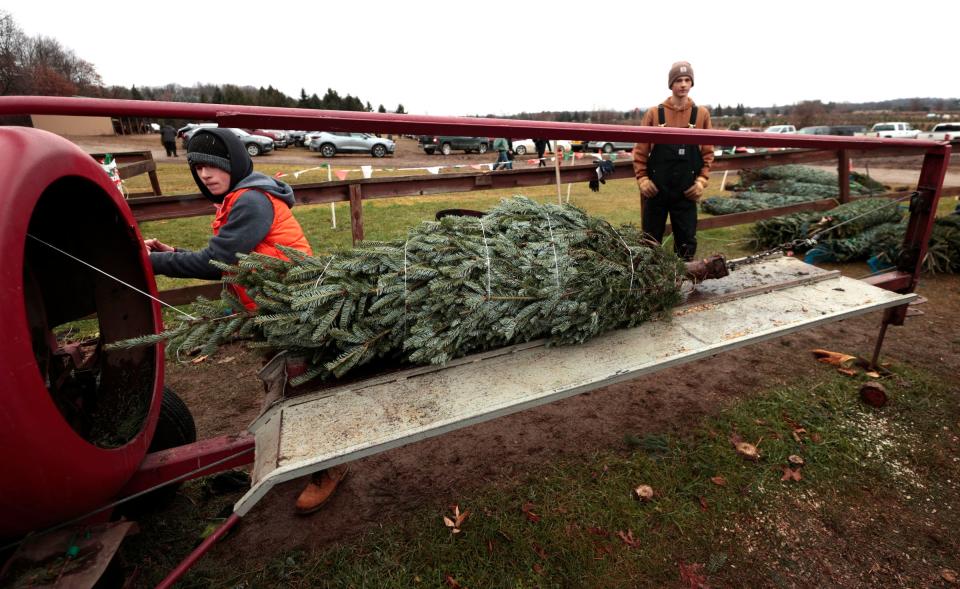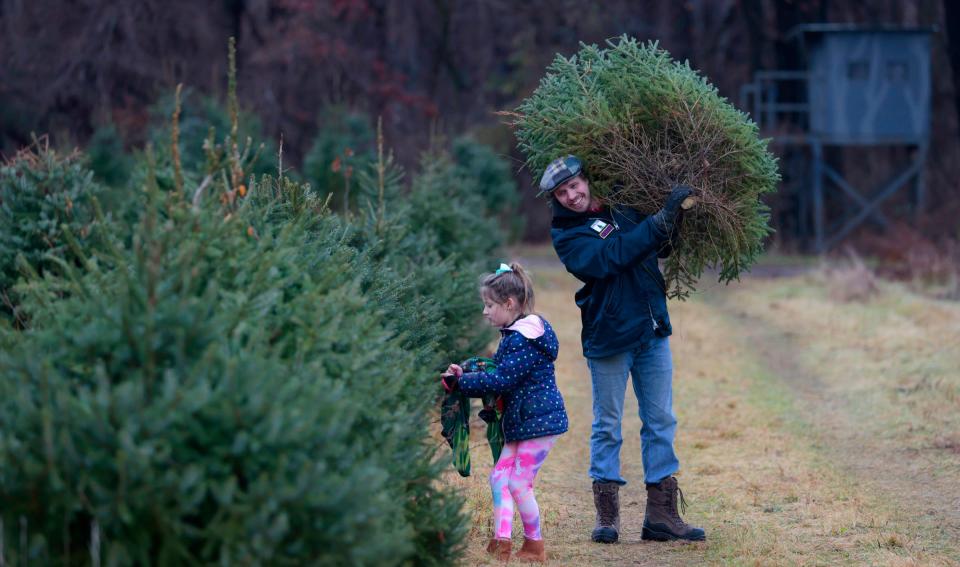The great Christmas tree debate: Real or fake? Michigan experts weigh in
It's the most wonderful time of the year, Andy Williams crooned. For many, it's also time to make a decision about whether to buy a freshly cut Christmas tree or invest in an artificial tree that can be packed away after the last refrain of "Auld Lang Syne" has been sung and hauled out again next season.
When weighing the options for how to deck your halls this year, there's plenty to consider — from the health effects of live versus artificial trees to the environmental impacts, along with cost.

The Free Press interviewed Bill Lindberg, a Michigan State University Extension Christmas tree educator from Ottawa County, along with Dr. Christian Nageotte, fellowship program director for allergy and clinical immunology at Henry Ford Health/Michigan State University, and consulted with other sources to help make your pro/con list a little easier.
Ah-ah-ah-choo! Consider allergies
The fresh scent of pine boughs fills many with holiday cheer, but it also can fill noses with pollen and other allergens, said Nageotte.
"When there are natural pine trees in homes for Christmas, there has been some association in patients having not only increased respiratory symptoms, but skin issues," he said.
The triggers for those symptoms include pollen from the pine tree itself, but also grass and weed pollen that can get caught up in needles and the bristle-like branches of evergreens. Mold can be a factor, too.
"Going back all the way to the 1930s, it was proposed that maybe it was the mold causing allergies among people with live Christmas trees in their homes," Nageotte said.
"The trees, of course, are outdoors and stacked in those lots and getting wet. Mold is prone to grow any kind of organic material, including tree bark and the needles. In one study that was done in the '70s they were unable in 11 different homes to measure any appreciable increase in mold spores ... that commonly grow on tree bark. But that's in contrast with other studies done in Canada, where they were able to measure Alternaria mold, which can cause sneezing and wheezing, congestion of the nose and so forth" in homes of people who had freshly cut Christmas trees.
The American Christmas Tree Association recommends using a garden hose to spray down your Christmas tree to wash away any pollen or dust that has accumulated on the branches. Then, put the tree somewhere warm outdoors and allow it to dry for about 24 hours (while keeping the trunk well watered) before you bring it into the house.
A sticky (and itchy) situation
Pollen and mold aren't the only irritants that freshly cut Christmas trees can bring into your home. Evergreens also have substances called resins and rosins in their sap.
When people haul evergreens into their homes, their skin often makes contact with those resins and rosins, which, Nageotte said, can cause "an immediate or even a delayed rash from the immune system's response to those irritant materials. It can persist for days to weeks if not addressed. It is very, very itchy and uncomfortable."
The itchy and scratchy situation can be avoided, he said, by wearing gloves and a long-sleeved shirt to protect your skin when moving a live tree or decorating it.
Artificial trees and the plastic problem
While artificial trees may seem like the better choice for people with allergies, they aren't a perfect solution, either. Artificial trees can gather dust and can harbor mold, especially when they're stored in basements and storage rooms where there are swings in humidity, Nageotte said.
But the bigger problem with artificial trees is that the vast majority of those sold in the U.S. are made in China. The soft plastic needles on those artificial trees often are made of polyvinyl chloride, or PVCs, which contain phthalates. Phthalates are endocrine-disrupting chemicals that have been associated with reproductive harm, cancer, asthma and neurodevelopmental problems.
Artificial trees also often are treated with flame retardants. While those chemicals have an important role in preventing fires, they also have been linked to such adverse health effects as cancer, thyroid and endocrine disruption, and reproductive harm.
Most choose artificial over freshly cut trees
Still, artificial trees remain the most popular choice of American consumers. According to the American Christmas Tree Association, 77% of people who plan to celebrate the holidays with a Christmas tree this year said they will choose an artificial tree.
Most told the ACTA for its annual survey that they prefer an artificial tree because it's easier to set it up and take it down, it doesn't require much maintenance, and it's a more budget-friendly option as it can be reused year after year.
Yet even if you reuse an artificial tree for a decade or more, Lindberg pointed out that eventually, they all end up in one place: "At some point, that's going to be thrown into a landfill. And of course, plastic pollution is a big issue for the environment."
But with a freshly cut tree, once the lights come off and the ornaments are packed away, it can be chipped and turned into mulch or compost.
Michigan's Christmas tree industry is 3rd largest in U.S.
Live trees are grown by American farmers — many of whom live and work right here in Michigan.
Michigan ranks third in the nation in the number of Christmas trees harvested, and supplies approximately 2 million Christmas trees each year to retailers across the U.S., according to the Michigan Ag Council. Roughly 37,000 acres of land in the Great Lakes State is devoted to growing Christmas trees.

"When you buy a real tree, you're supporting the local industry, supporting American farmers versus Chinese factories," Lindberg said. "And when you get a live tree, you also are bringing into your house that awesome smell."
Though it might seem as if cutting down a tree every year for your holiday decorations could lead to deforestation, the Michigan Ag Council reports that every time a Christmas tree is cut down, farmers plant three new ones.
Getting a freshly cut tree for the holidays also is an experience, Lindberg said. It's a way to make memories with family and friends and "have an outdoor activity that everyone can partake in."
Once you've picked your favorite one, Lindberg said it should be shaken, not stirred, to ensure you don't bring freeloaders home along with your tree.
"If you choose your tree at a farm, the tree will be shaken there using a vibrating device that will shake off any bugs or critters or loose needles," he said. The same should be true of any freshly cut tree from retailers like Home Depot or Lowe's.
After that, the key to keeping the tree fresh and avoiding a fire hazard is to ensure it is well watered, Lindberg said.
"People do like that smell in the house and that smell can make people happier and improve their mood," Lindberg said.
Lindberg's vote: freshly cut tree.
Nageotte has an artificial tree, though he said: "My wife keeps trying to get me to get rid of it. I'm trying to make it last as long as possible because those things are so ridiculously expensive nowadays."
Contact Kristen Shamus: kshamus@freepress.com. Subscribe to the Free Press.
This article originally appeared on Detroit Free Press: The Christmas tree debate: Real or fake? Michigan experts weigh in

